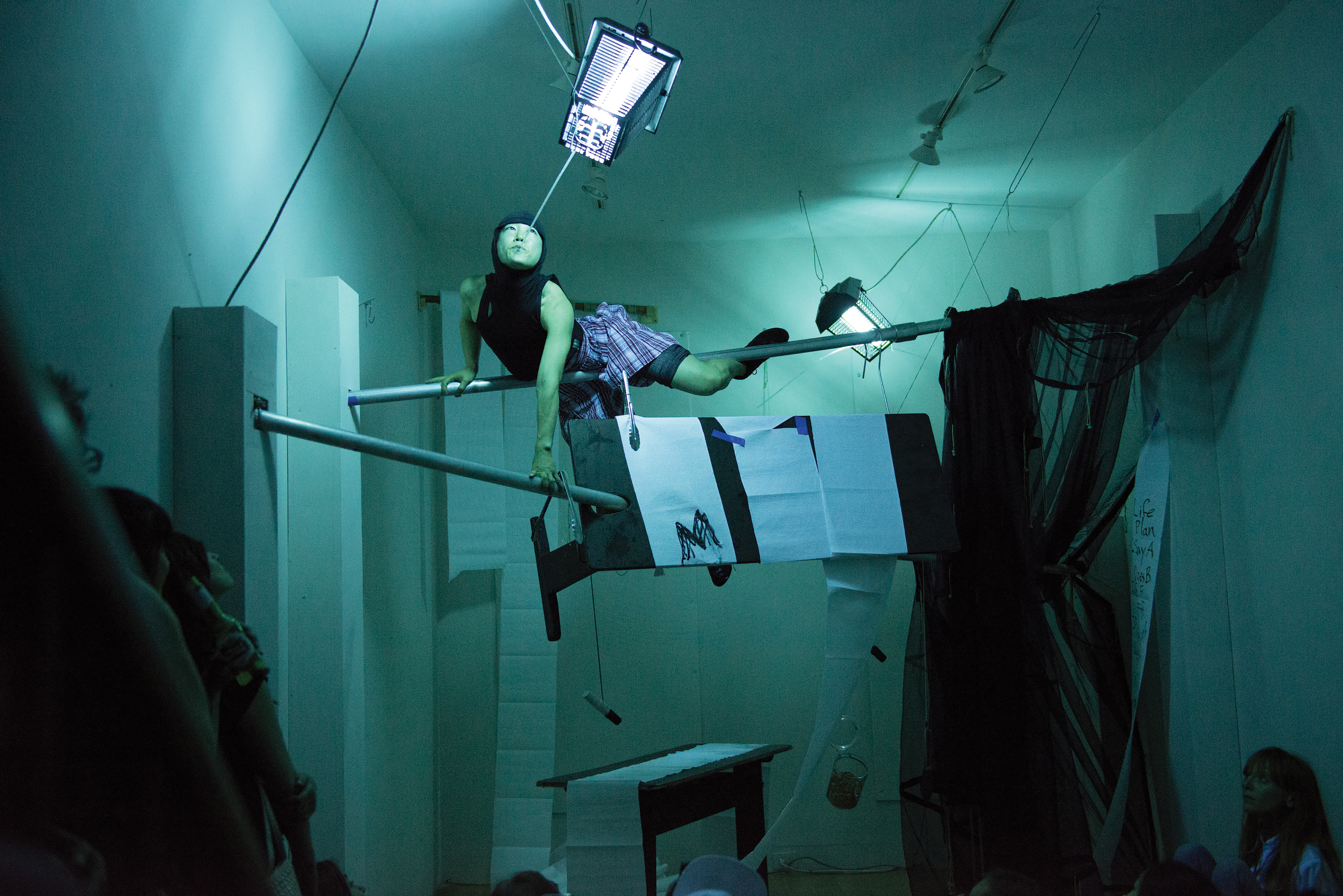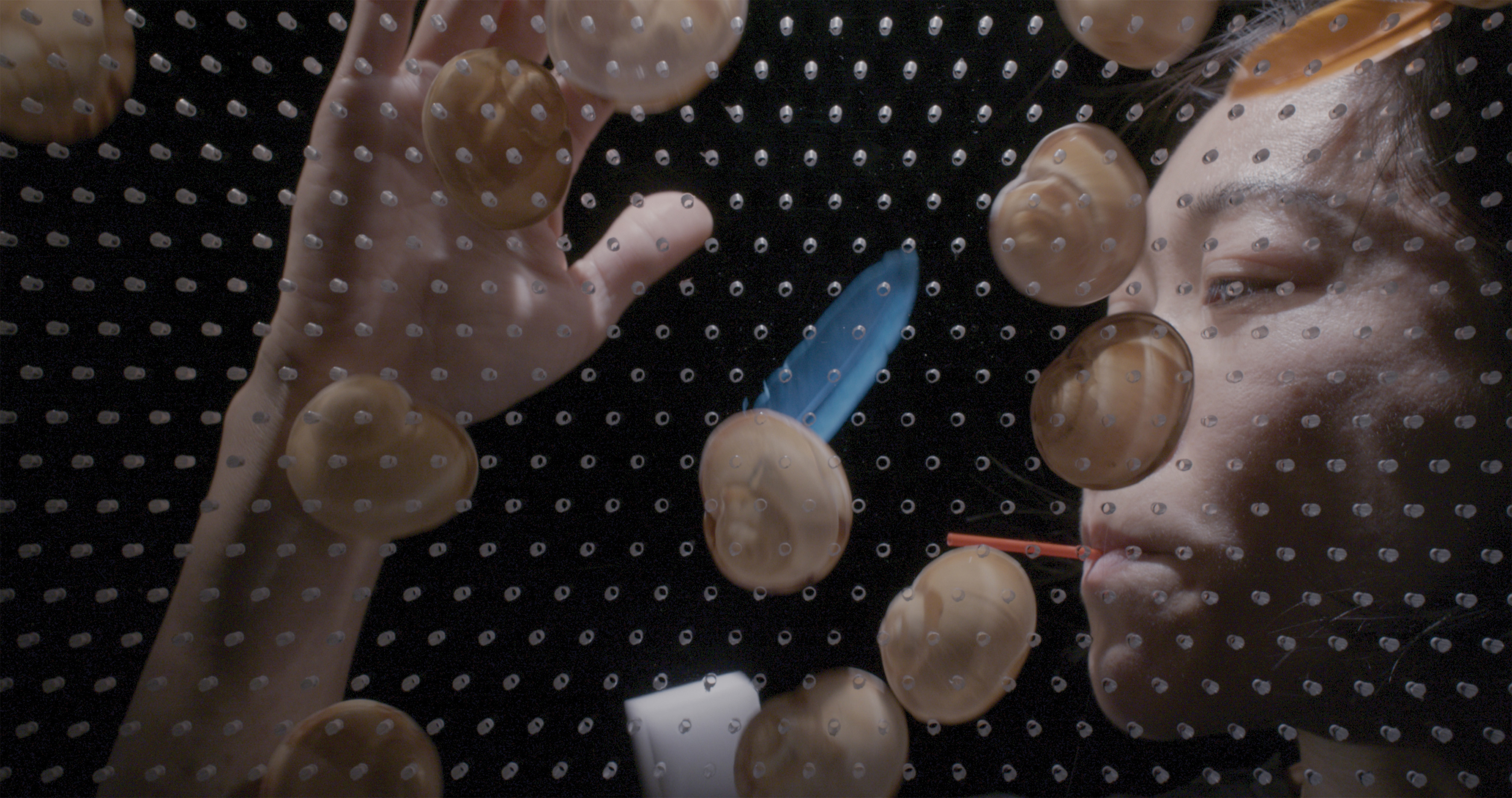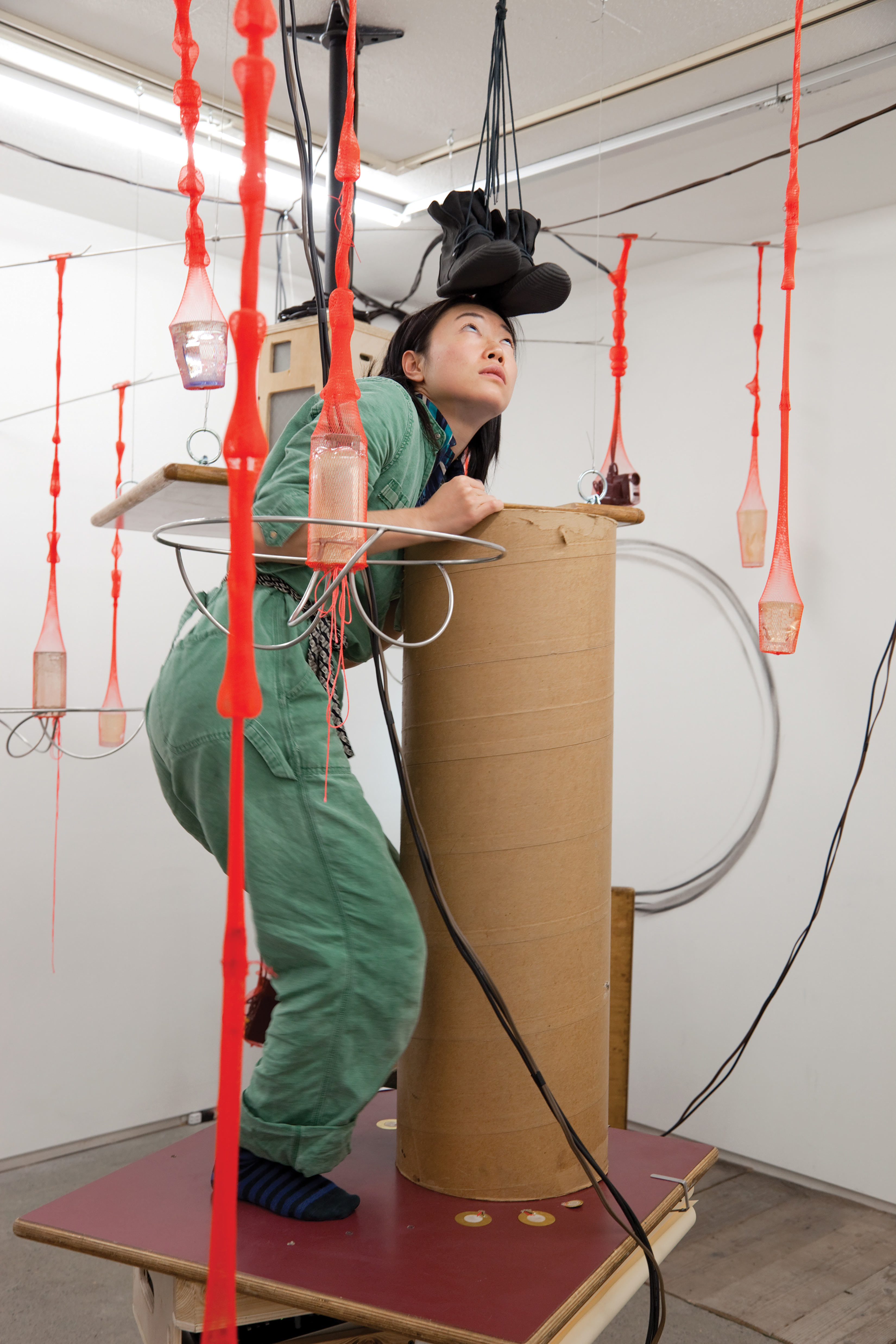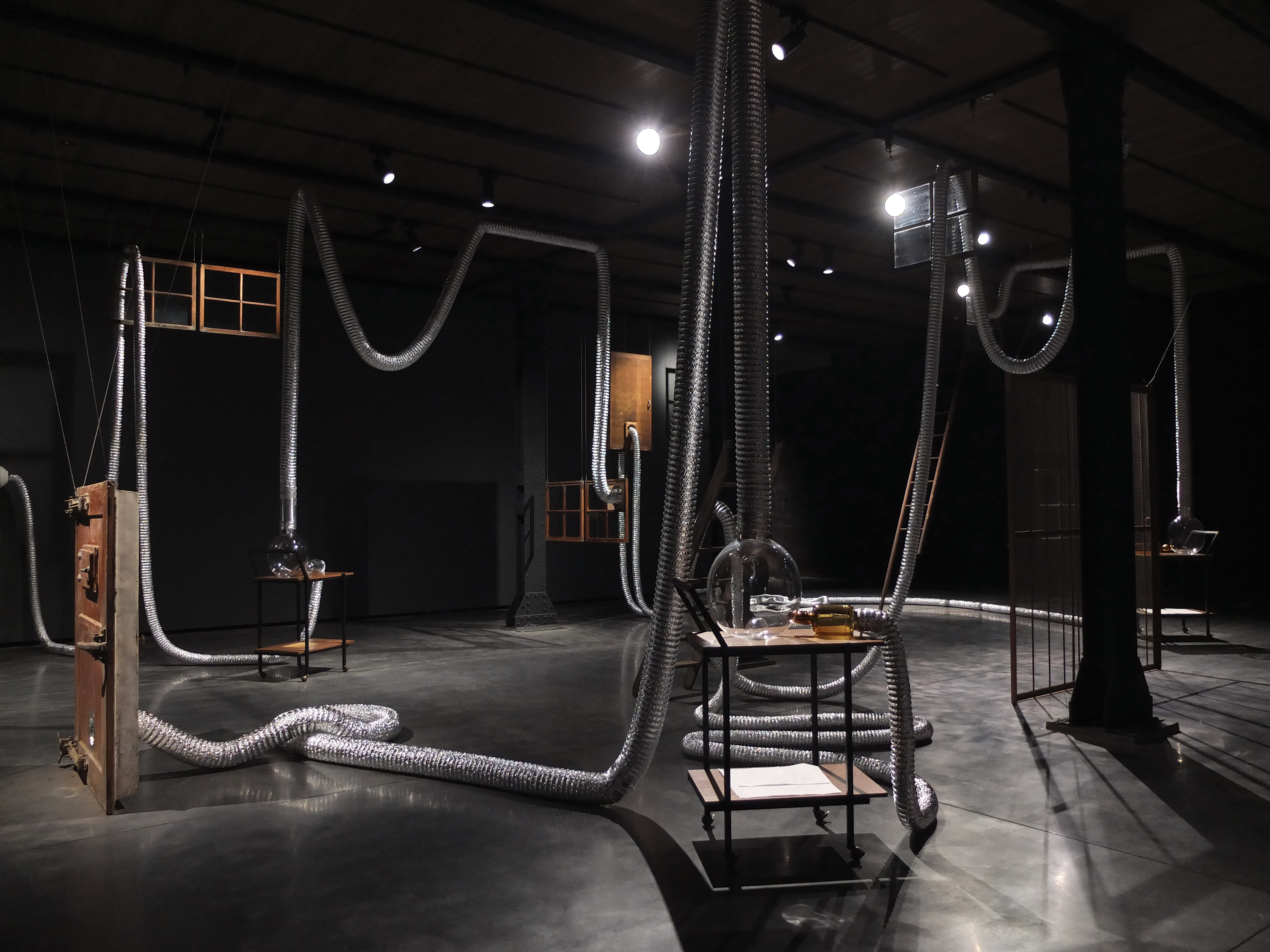F L A U N T


Yokohama-born, New York-based artist Aki Sasamoto’s eccentric (yet ultimately moving) installations, usually activated and expanded with improvisation-heavy performances, reveal to us that everyday objects are always already on the edge of animacy—when and if infused with the right kind of discursive elements borrowed from other disciplines. For the past two decades, Sasamoto has created a semi-encyclopedic body of works, with an array of references ranging from ecology to mathematics that willfully search for systems unnoticed and worlds unthought.
The artist’s mid-career survey at the Museum of Contemporary Art, Tokyo, Aki Sasamoto’s Life Laboratory, proves just that: as much as Sasamoto’s two-decades of production consistently deploys language, her fondness for chance, accident, and language’s shadows will always generate works that prove stubbornly elusive, refusing to be captured by delimited structures. In turn, these works become a window to peek into almost-utopian times and places for the artist herself and viewers alike.
Included in the retrospective, Sasamoto’s early works such as “cooking show” (2005) and “remembering/modifying/developing” (2007) delight in each system’s orderlessness. These early works already demonstrate a persistence logic throughout Sasamoto’s career, namely how she enacts her own body in relation to a world of objects. Sometimes Sasamoto functions as an intermediary agent between elements, in the case of “cooking show,” where the artist holds an exceedingly long knife, attempting to cut fruits and vegetables with force and precision. Other times, the artist activates relations and reverberations, as seen in “remembering/modifying/developing,” where various balancing acts between the artist and an elaborated mobile installation connected by steel arms produce atonal music.

Indeed, often Sasamoto’s practice isolates gestures of mundane activities and estranges their processes, leading to novel ways of experiencing self and time. Such fluidity, particularly manifested when life and art evolve with each other, fascinates Sasamoto, who had substantial training in dance and theater. Recalling going behind the scenes of cooking shows, the artist locates inspirations in artificial situations: “I saw the sets that enabled cuts and zoom-ins and was struck by the edits that allows perspective shifts,” she says. “Before the introduction of such a storyboarding of a TV show, cookbooks have already distilled the duration of actual cooking to staged steps in simpler chopped up sentences. In a theatrical time, I attempted to put these chopped up narrative back together real time.”
Other early works showcase Sasamoto’s interest in how mysteries are inherent to natural and social phenomena, evading theory’s full domestication. “Strange Attractors” (2010) is inspired by the Lorenz system, a system that can engender drastically, chaotically different results from small change in input. Part refurbished stool, part steel sculpture in the shape of a mathematical graph, the work is perhaps a reminder that the eruption of spontaneity is inevitable, even from materials at arm’s length.
“Humans like to come up with a way to understand phenomena. The invention of theories such as numbers, gravity, black hole, and scale all have such an impact on how we see and experience the world. Chaos Theory is one of them,” Sasamoto explains of her interest in the world-building capabilities of mathematics and physics. “Many subsequent discoveries as well as new designs and productions rely on the initial condition or set of parameters we agree to view the world by.” Yet again, her exercise in deciphering a system’s explanatory power only further denaturalizes said system.

Once repurposed in the quasi-autobiographical room installation/performance “Secrets of My Mother’s Child,” (2009) mostly consisted of a second-hanging wooden closet and a table,“X x Y = 1” (2009) is restored with capacities for signifying the domestic. Perhaps, then, details of the mother-daughter relation, or memories of them, which the performance spirals from and returns to, will be ever unpredictable too?
In the performance, Sasamoto narrates real and fabricated events from her childhood, while video footage from cameras planted in a closet playback simultaneously on a monitor, a fitting metaphor for the surveillance of one’s inner psyche to bring about psychoanalytic materials. Midway through this performance, Sasamoto, attached to a bungee chord, crawls into said closet, later emerging from it’s drawers. The artist then proceeds to hang socks from the closet with clothespins on a suspended partial rack, her mannerisms deadpan and affectless, reorienting the performance towards the domestic and the representation of labor. Can materials sourced from real life be just materials? Sasamoto wonders, despite how psychoanalysis, somewhat influential in 2000s MFA programs, insists on expressing truth through interrogating every speech, act, and affect.
“Strange Attractors” (2010) and “Skewed Lies” (2010) are both elaborated sets that concern chaotic systems. In “Strange Attractors,” which literally addresses the eponymous numerical values that moves within a bounded, yet infinite, set of paths, the artist draws diagrams notating structures of our shared reality and gives new, semi-conspiratorial meanings to everyday words and phrases, all while squeezing her body in and out of cardboard tubes, against hanging red fishnet sacks containing tumbler glass and metal sculptures shaped like strange attractors. In “Skewed Lies,” the artist moves through plastic milk crates, lead pipes, and desks, giving confessional presentations on her personal life and again drawing diagrams that relate, as if magically, multiple inquiries: mosquitos, legality, comedy, and Jean Genet.
Yet, Sasamoto’s penchant for humor and improvisation does not aim to conceal the uncomfortably unpredictable nature of the real. The artist admits that she enjoys success and failure equally in understanding the world: “I pour several seemingly disconnected concerns into the project to see if they align. A project is a space for me to attempt alignments. In “Skewed Lies,” I literally was asking how to align or connect the dots. And the outcome of the work for me was that some will, by simply sharing the space and time, and others just will never meet.”

Later works, from “Wrong Happy Hour” (2014) to “Do Nut Diagram” (2018), gesture toward the social and the relational. In “Wrong Happy Hour,” Sasamoto diagrams archetypes of romance, control or lack thereof, the border between commerce and community in an installation in the form of an unwelcoming and rapidly shrinking bar. In the video “Do Nut Diagram,” a donut seemingly levitates in a lush forest, until the presence of translucent screens is revealed. The artist draws a Venn diagram with the donut, referencing Doughnut economics, a development model that prioritizes equity and ecology. Glass screens are smashed and cleaned, rendering Sasamoto’s already opaque instruction ever more fictive.
Sasamoto’s recent works—“Spirits Cubed” (2020), “Point Reflection (Video)” (2023), “Sounding Lines” (2024), and “catch or be caught” (2025)—engage with beyond-human entities and cycles of production and reproduction, calling to mind spirits lingering in a former apple cider factory, animism, or the fishing industry. A discrete HVAC system creates the illusion that objects are moving on themselves. A motorized arm whips springs connecting larger-than-life baits and lures, which then choreographs in unison. These ghostly movements are not only sites where meanings are repeatedly construed but also recall a fantastical state of union among mind, body, and object of desire that have long been repressed.

Through November, Sasamoto will revisit three performances—“Skewed Lies,” “Strange Attractors,” and “Spirits Cubed”—in the museum spaces, and debut a new performance “Sounding Lines, catch or be caught” (2025). Extending and reinterpreting her prior performances, Sasamoto reflects on the open-ended nature of her performance practice. Often, each object in a given installation is assigned with a score. “A hole of slit ‘requests’ me to go in, a trampoline ‘requests’ me to jump on,” the artist declares. The scores, however, can be betrayed, for the artist’s muscle memories, affective tendencies, and intellectual inclinations take on new meanings and contexts in a new environment. Each performance is also an act of rediscovery for Sasamoto herself.
For Sasamoto, to know the world is to tend to the ways in which objects demand interpretations and simultaneously exceed such interpretations. In this vexed dance with her objects, Aki Sasamoto eventually accesses latent registers of transmuted emotions and concealed revelations, even just for a moment. Once the material world’s most fundamental operative fabrics, the web of things that moves and is moved by us, are penetrated through, other frames of reference far more seductive and mystical emerge.